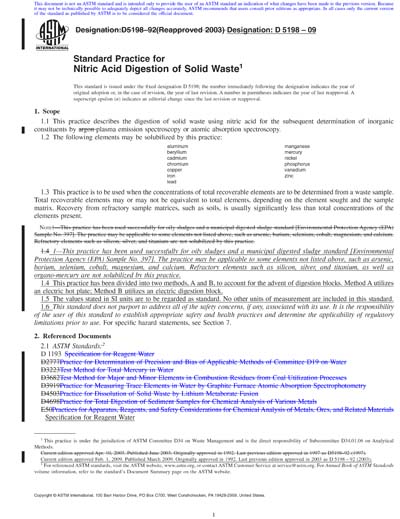Historical
ASTM D5198-09 Red
Standard Practice for Nitric Acid Digestion of Solid Waste (Standard + Redline PDF Bundle)
1.1 This practice describes the digestion of solid waste using nitric acid for the subsequent determination of inorganic constituents by plasma emission spectroscopy or atomic absorption spectroscopy.
1.2 The following elements may be solubilized by this practice:
1.3 This practice is to be used when the concentrations of total recoverable elements are to be determined from a waste sample. Total recoverable elements may or may not be equivalent to total elements, depending on the element sought and the sample matrix. Recovery from refractory sample matrices, such as soils, is usually significantly less than total concentrations of the elements present.
Note 1—This practice has been used successfully for oily sludges and a municipal digested sludge standard [Environmental Protection Agency (EPA) Sample No. 397]. The practice may be applicable to some elements not listed above, such as arsenic, barium, selenium, cobalt, magnesium, and calcium. Refractory elements such as silicon, silver, and titanium, as well as organo-mercury are not solubilized by this practice.
1.4 This practice has been divided into two methods, A and B, to account for the advent of digestion blocks. Method A utilizes an electric hot plate; Method B utilizes an electric digestion block.
1.5 The values stated in SI units are to be regarded as standard. No other units of measurement are included in this standard.
1.6 This standard does not purport to address all of the safety concerns, if any, associated with its use. It is the responsibility of the user of this standard to establish appropriate safety and health practices and determine the applicability of regulatory limitations prior to use. For specific hazard statements, see Section 7.
ASTM International [astm]

